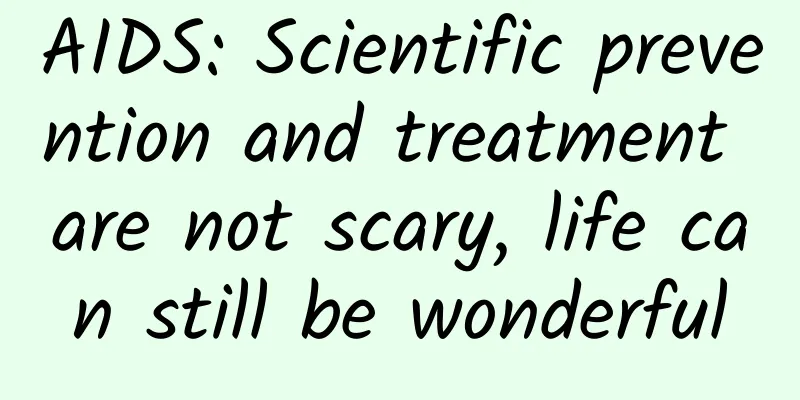AIDS: Scientific prevention and treatment are not scary, life can still be wonderful

|
AIDS, a disease that once caused global panic in the early 1980s, is no longer an untouchable taboo. With the advancement of medicine and the deepening of social cognition, more and more people have begun to look at AIDS rationally and actively participate in prevention and treatment. In fact, as long as you understand the knowledge of AIDS prevention and treatment and take scientific precautions, AIDS is not terrible and life can still be wonderful. 1. Understanding AIDS AIDS, or acquired immunodeficiency syndrome (AIDS), is an infectious disease caused by the human immunodeficiency virus (HIV). HIV mainly attacks the human immune system, especially CD4+T lymphocytes, causing the infected person's immunity to decline, which in turn causes them to be attacked by various infections and diseases. There are three main ways of HIV transmission: sexual transmission, blood transmission, and mother-to-child transmission. Sexual transmission is the main mode of transmission, including unprotected sex, contact with multiple sexual partners, etc. Blood transmission usually occurs during the process of sharing syringes, blood transfusions, or organ transplants. Mother-to-child transmission is when a mother transmits the virus to her baby during pregnancy, childbirth, or breastfeeding. 2. Prevention of AIDS 1. Promote safe sex. Avoiding unprotected sex is the key to preventing AIDS. Using condoms during sex can effectively reduce the risk of HIV transmission. In addition, reducing the number of sexual partners and avoiding sex with strangers are also effective measures to prevent the spread of sexually transmitted diseases. 2. Avoid contact with blood. Do not share sharp objects such as syringes and needles with others, and do not participate in illegal blood transfusions and organ transplants to reduce the risk of blood transmission. If you need to receive medical treatment, you should choose a regular medical institution. 3. Pay attention to the health of mothers and infants. Pregnant women should undergo HIV testing before and after pregnancy. If the test result is positive, they should receive timely treatment and take measures to block mother-to-child transmission. In addition, breastfeeding women should also avoid breastfeeding to reduce the risk of infant infection. 4. Protection in daily life. In daily life, general contact with HIV carriers, such as shaking hands, hugging, and eating together, will not infect people. However, in order to avoid accidental infection, we should try to avoid contact with other people's blood and body fluids, especially when the skin is broken. III. Diagnosis and Treatment of AIDS 1. Diagnosis. Blood test: The diagnosis of AIDS mainly relies on blood test. This test can detect HIV antibodies or viral load in the blood, thus providing doctors with clear information about whether HIV is infected and the severity of the disease. HIV antibody test: This test detects HIV antibodies in the blood. If the antibody test is positive within a few weeks to months after HIV exposure, it means that the person has been infected with HIV. However, some people may not have antibodies detected immediately in the early stages of infection. This period of time is called the "window period." Viral load test: This test measures the amount of HIV virus in your blood. The higher the viral load, the more actively the virus is replicating and the more severe your disease may be. Viral load testing is important for evaluating how well treatment is working and how your disease is progressing. Other diagnostic tests: In addition to blood tests, your doctor may use other diagnostic tests, such as CD4 cell count (a test that measures the health of your immune system) and HIV genotype testing (used to determine the specific type of HIV virus in a person's body to help choose the most effective treatment). 2. Treatment. Antiviral drug treatment: Antiviral drugs are the core of AIDS treatment. These drugs can inhibit viral replication and reduce viral load, thereby delaying the progression of the disease and improving the quality of life of HIV carriers. Commonly used antiviral drugs include nucleoside reverse transcriptase inhibitors, non-nucleoside reverse transcriptase inhibitors and protease inhibitors. Immunotherapy: Immunotherapy aims to strengthen the immune system of people with HIV so that they can better fight infection and disease. This may include the use of immunomodulatory drugs, such as interleukin-2 and interferon, to stimulate the immune system's response. Comprehensive treatment: In addition to antiviral drug treatment and immunotherapy, doctors may also provide other comprehensive treatments for HIV carriers, such as nutritional support, psychotherapy and social support. These treatments can help HIV carriers cope with the various challenges brought by the disease and improve their quality of life. 4. Providing care and support to AIDS patients AIDS patients not only need medical treatment, but also need social care and support. We should eliminate discrimination and prejudice against AIDS patients and treat them with equality, respect and care. At the same time, the government and social organizations should also strengthen their care for AIDS patients, provide them with psychological support, life assistance and employment guidance, and help them reintegrate into society. AIDS is not terrible. As long as we treat it with a scientific attitude and take active preventive measures, we can greatly reduce the risk of infection. At the same time, we should also give care and support to those infected, help them overcome the disease and regain confidence in life. Author: Chen Kaige, Wuzhou Third People's Hospital |
<<: COPD "Mission Impossible Crisis" | COPD complications that cannot be ignored
>>: Eliminate the fear of chemotherapy and actively respond to treatment
Recommend
How to quickly relieve the pain of dysmenorrhea in summer
Many female friends will have some physiological ...
How to treat dryness below
What should women do if they have vaginal dryness...
Do I need to hang water after abortion?
After an abortion, you need to hang intravenous d...
Why do I bleed again after my period?
Many female friends worry about menstrual disorde...
Why is the ugly orange called unknown fire? Which is better, the babao orange or the unknown fire?
The unknown fire is very popular among people, ma...
Girls have pain just below their belly button
If a girl has pain below her belly button, it is ...
How many days after menstruation is it easiest to get pregnant?
Many women who are preparing for pregnancy start ...
What is the cause of female ovulation and implantation bleeding?
Implantation bleeding in women is relatively rare...
Rhinitis is always prevalent in spring? Can it really be cured?
Spring is here, how is your nose? Is your nose sn...
Will eating flower cakes make you fat? What are the functions of flower cakes?
Flower cakes are a natural and healthy tonic with...
How long does it take for a pregnant woman to discharge lochia after childbirth?
Generally speaking, when a mother who has been pr...
Female general weakness, nausea and vomiting
Many people have said that they sometimes feel we...
Do you have the same dark circles as Nezha? Don’t worry, these 4 methods are useful!
If you ask who is the most popular this Spring Fe...
What is the Cang Xue Long Yin Mu Bai Shou based on? Where can I read the Cang Xue Long Yin Mu Bai Shou novel?
Every year when the winter vacation comes, a larg...
Down syndrome screening result is low risk
Down syndrome screening is very critical. If this...









